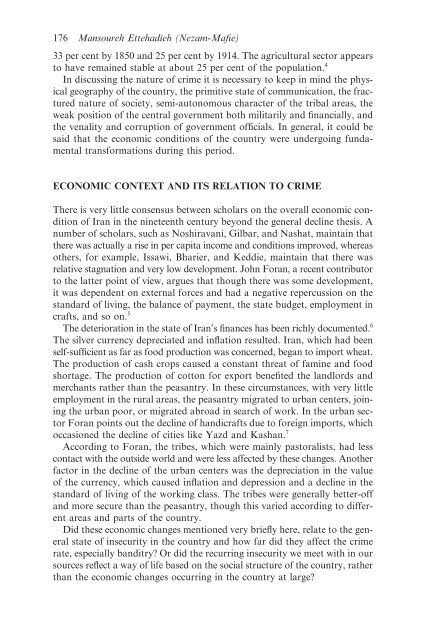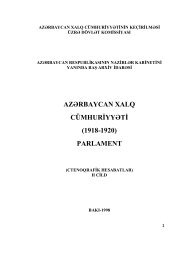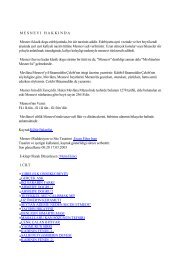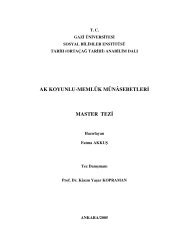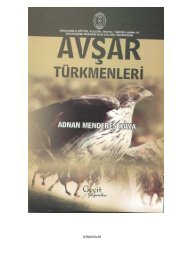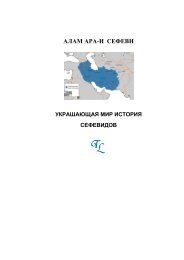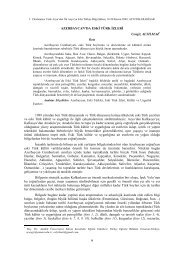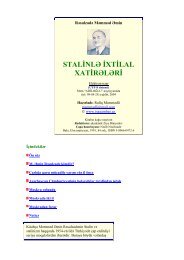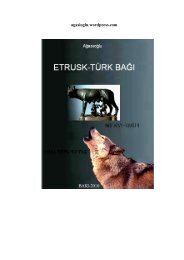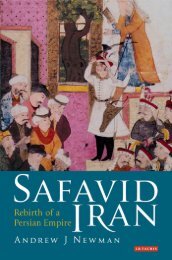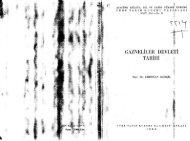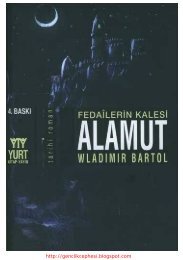War and Peace in Qajar Persia: Implications Past and ... - Oguzlar.az
War and Peace in Qajar Persia: Implications Past and ... - Oguzlar.az
War and Peace in Qajar Persia: Implications Past and ... - Oguzlar.az
- No tags were found...
Create successful ePaper yourself
Turn your PDF publications into a flip-book with our unique Google optimized e-Paper software.
176 Mansoureh Ettehadieh (Nezam-Mafie)33 per cent by 1850 <strong>and</strong> 25 per cent by 1914. The agricultural sector appearsto have rema<strong>in</strong>ed stable at about 25 per cent of the population. 4In discuss<strong>in</strong>g the nature of crime it is necessary to keep <strong>in</strong> m<strong>in</strong>d the physicalgeography of the country, the primitive state of communication, the fracturednature of society, semi-autonomous character of the tribal areas, theweak position of the central government both militarily <strong>and</strong> f<strong>in</strong>ancially, <strong>and</strong>the venality <strong>and</strong> corruption of government officials. In general, it could besaid that the economic conditions of the country were undergo<strong>in</strong>g fundamentaltransformations dur<strong>in</strong>g this period.ECONOMIC CONTEXT AND ITS RELATION TO CRIMEThere is very little consensus between scholars on the overall economic conditionof Iran <strong>in</strong> the n<strong>in</strong>eteenth century beyond the general decl<strong>in</strong>e thesis. Anumber of scholars, such as Noshiravani, Gilbar, <strong>and</strong> Nashat, ma<strong>in</strong>ta<strong>in</strong> thatthere was actually a rise <strong>in</strong> per capita <strong>in</strong>come <strong>and</strong> conditions improved, whereasothers, for example, Issawi, Bharier, <strong>and</strong> Keddie, ma<strong>in</strong>ta<strong>in</strong> that there wasrelative stagnation <strong>and</strong> very low development. John Foran, a recent contributorto the latter po<strong>in</strong>t of view, argues that though there was some development,it was dependent on external forces <strong>and</strong> had a negative repercussion on thest<strong>and</strong>ard of liv<strong>in</strong>g, the balance of payment, the state budget, employment <strong>in</strong>crafts, <strong>and</strong> so on. 5The deterioration <strong>in</strong> the state of Iran’s f<strong>in</strong>ances has been richly documented. 6The silver currency depreciated <strong>and</strong> <strong>in</strong>flation resulted. Iran, which had beenself-sufficient as far as food production was concerned, began to import wheat.The production of cash crops caused a constant threat of fam<strong>in</strong>e <strong>and</strong> foodshortage. The production of cotton for export benefited the l<strong>and</strong>lords <strong>and</strong>merchants rather than the peasantry. In these circumstances, with very littleemployment <strong>in</strong> the rural areas, the peasantry migrated to urban centers, jo<strong>in</strong><strong>in</strong>gthe urban poor, or migrated abroad <strong>in</strong> search of work. In the urban sectorForan po<strong>in</strong>ts out the decl<strong>in</strong>e of h<strong>and</strong>icrafts due to foreign imports, whichoccasioned the decl<strong>in</strong>e of cities like Y<strong>az</strong>d <strong>and</strong> Kashan. 7Accord<strong>in</strong>g to Foran, the tribes, which were ma<strong>in</strong>ly pastoralists, had lesscontact with the outside world <strong>and</strong> were less affected by these changes. Anotherfactor <strong>in</strong> the decl<strong>in</strong>e of the urban centers was the depreciation <strong>in</strong> the valueof the currency, which caused <strong>in</strong>flation <strong>and</strong> depression <strong>and</strong> a decl<strong>in</strong>e <strong>in</strong> thest<strong>and</strong>ard of liv<strong>in</strong>g of the work<strong>in</strong>g class. The tribes were generally better-off<strong>and</strong> more secure than the peasantry, though this varied accord<strong>in</strong>g to differentareas <strong>and</strong> parts of the country.Did these economic changes mentioned very briefly here, relate to the generalstate of <strong>in</strong>security <strong>in</strong> the country <strong>and</strong> how far did they affect the crimerate, especially b<strong>and</strong>itry? Or did the recurr<strong>in</strong>g <strong>in</strong>security we meet with <strong>in</strong> oursources reflect a way of life based on the social structure of the country, ratherthan the economic changes occurr<strong>in</strong>g <strong>in</strong> the country at large?


